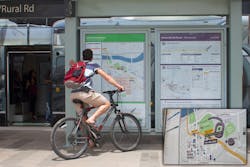Digital technology applications are changing the way we think about signage for the public transportation industry. Technology allows for real-time, accurate information and offers the opportunity to provide more effective wayfinding information than with static information.
Wayfinding: The science of navigation in public spaces.
In transit, wayfinding has traditionally taken the form of static information, such as flags on bus stop poles, system maps in transit centers, station identity names fastened to walls, in-vehicle placards on rail cars and in buses, etc. All of this begins to build an information network for the rider. However, with few exceptions, deployment of a thorough and effective static wayfinding system in public transit has not been successful in the U.S. Why? Primarily it comes down to the cost of deploying the necessary amount of static information and then maintaining it. When a schedule or route changes, static information must be updated, which requires enormous time and money from agencies, especially when thousands of stops are involved. Digital signage offers exciting solutions for building a robust wayfinding system.
Cognitive load: The intellectual pressure that is placed upon a person during decision-making situations.
Extensive research indicates there is 8 seconds to communicate information clearly and concisely, otherwise passengers become frustrated and dissatisfied and are less likely to turn to public transport if they have other options.
The transit industry is complex from a logistics and coordination perspective. One of the key strategies to address is striking the correct balance between providing useful wayfinding information for public transit users while respecting their cognitive load. That is, providing only that amount of information a rider needs to complete a task, and no more. Certainly, the more complex the decision-making process, the higher the cognitive load. And to complicate this important topic further, everyone has a different cognitive capacity.
Transit networks are, in essence, a complex puzzle. The job of wayfinding designers is to make that puzzle solvable.
With all the technology touch points available — mobile phones, digital watches, interactive kiosks, digital signage — one might argue that you can maximize the amount of information conveyed. But this is just not the case. We must take into account what an acceptable amount of information can be provided to an average individual during their decision making process in order to deliver relevant, useful information rather than lots of information.
Technology Solutions for Transit Centers and Rail Station
Transit centers, rail stations and airports are busy places with multiple travel options for passengers to consider. Digital solutions, like touchscreen kiosks, are able to provide the correct information hierarchy for transit in a way that helps transit riders get the information they want and need.
What do riders want to know at their point of departure? They want to understand routes — where they go and when they arrive —– and to understand how to get to a new location and be confident in their decisions. Touchscreen kiosks should focus on giving a rider as much or as little detail about a particular route as that individual is looking for.
The third fundamental information requirement sought by transit riders is trip planning. Riders are often looking for detailed directions from Point A to Point B and they want those directions with them to increase their comfort level while on the trip. An added benefit for many riders is being able to see other travel mode options as well. Maybe they want to ride their bike rather than, or as part of, taking the bus. Regardless, riders like to have a trip plan and that’s where including the ability to text or email the trip directly from the digital display or kiosk is another important and useful tool.
Santa Barbara Metropolitan Transit District (MTD) uses CHK America’s ConnectPoint kiosk and has seen a dramatic reduction in the number of questions asked at the customer service windows, freeing staff to handle other responsibilities. MTD Transit Center Supervisor Mel Deaile said, “The kiosk is an invaluable information tool for our customers.”
Dallas Area Rapid Transit (DART) Vice President, Chief Marketing Officer Nevin Grinnell stated, “DART is preparing to deploy its first ConnectPoint Interactive Kiosk at Love Field.
“This technology should have an immediate impact on our customers by providing them with an intuitive useful interface into DART’s service from the airport.”
Technology Solutions at Stops
The second most important decision point during a customer’s journey is at the bus stop. This has always been a stage where keeping service information current, accurate and user friendly has been difficult and expensive. The majority of bus stops do not have electrical power so providing real-time or service alerts has been a challenge.
Digital signage can provide a solution at the bus stop. The Digital Bus Stop, based on E-Ink technology, requires no electrical infrastructure improvements. Real-time departure and service alerts are delivered using solar power and schedule information and service alerts are delivered with battery power. The information is also updated remotely; everything is driven by the backend.
Another tool could potentially be a mobile phone, though a recent USA Today article revealed that 38 percent of transit customers want departure information provided to them at the bus stop. Furthermore, a Pew Research Study in October 2015 revealed that only 52 percent of adults with a household income of less than $30,000 own a smartphone. Other challenges to consider include the expense of data and text charges, inputting location correctly, and small screens. These variables add to cognitive load and increase the probability that a mistake could be made.
“CHK has been a great partner during our wayfinding redesign. The natural next step for us to explore is their digital bus stop products, which are based on E-Ink technology. We want to look at all amenity options for our current and new riders. After all, Orlando is the number one tourist destination in the world and we want to provide our customers what they expect as far as bus stop information without us incurring expensive infrastructure improvements,” stated Matthew Freidman, director of marketing, Lynx.
Advanced digital signage is providing more flexibility to transit agencies and better information to customers. It is essential to use the most effective tools to affect the most positive results.
Rick Wood is President and Chief Executive Officer of CHK America.
Rick Wood | CEO, Connectpoint
Connectpoint Founder and CEO Rick Wood has led the transformative company since 2018.


